 W
WThe Amazing 3, known in Japan as W3 or Wonder 3 , is a Japanese manga and a black and white anime series created by Osamu Tezuka in the 1960s. It involves the adventures of three agents from outer space who are sent to Earth to determine whether the planet, a potential threat to the universe, should be destroyed. Landing on Earth, the characters take the form of a rabbit, a horse and a duck, and make friends with a young human boy.
 W
WAmbassador Magma is the title and protagonist of a manga and tokusatsu TV series created by Osamu Tezuka. The TV series, produced by P Productions, Seven Arts Television and Krantz Films, was aired on Fuji TV from July 4, 1966, to June 26, 1967, lasting a total of 52 episodes. It is the first color tokusatsu TV series in Japan, beating Tsuburaya Productions' Ultraman to the air by six days. The show later aired in the US, dubbed in English, as The Space Giants. Digital Manga crowdfunded the manga, and it is currently available for digital purchase on their Emanga site.
 W
WAstro Boy is a Japanese television series that premiered on Fuji TV on New Year's Day, 1963, and is the first popular animated Japanese television series that embodied the aesthetic that later became familiar worldwide as anime. It originated as a manga of the same name in 1952 by Osamu Tezuka, revered in Japan as the "God of Manga." It lasted for four seasons, with a total of 193 episodes, the final episode presented on a Saturday, New Year's Eve 1966.
 W
WAstro Boy , sometimes referred to as New Mighty Atom , is a color remake of the 1960s anime black-and-white series of the same name(s); both series are adapted from the manga series by Osamu Tezuka.
 W
WAstro Boy is a remake of the 1960s anime series of the same name created by Osamu Tezuka. Produced by Tezuka Productions, Sony Pictures Entertainment Japan, Animax, Dentsu, and Fuji TV, it was directed by Kazuya Konaka, with Marc Handler and Joe D'Ambrosia handling series scripts, Shinji Seya designing the characters, Shinji Aramaki and Takeshi Takakura designing the mechanical elements, Keiichirō Mochizuki serving as chief animation director, and Takashi Yoshimatsu composing the music. The anime was created to celebrate the birthdate of Atom/Astro Boy, as well as the 40th anniversary of the original TV series. It kept the same classic art style as the original manga and anime, but was renewed and modernized with more lush, high-quality, near-theatrical animation and visuals, combining the playfulness of the early anime with the darker, more serious and dramatic science fiction themes of the manga and the 1980 series. The anime was broadcast in Japan on Fuji TV from April 6, 2003 to March 28, 2004, every Sunday from 9:30 to 10:00 JST, for a total of 50 episodes, and it was also aired outside of Japan on Kids' WB in the US and other local broadcasters overseas.
 W
WAstro Boy: Mighty Atom – Visitor of 100,000 Light Years, IGZA is a 2005 Japanese anime science fiction adventure film based on the 2003 Astro Boy TV series made by Tezuka Productions and directed by Yoshio Takeuchi. It was released on September 1, 2005, and is Japan's first full-length animated large-scale IMAX film.
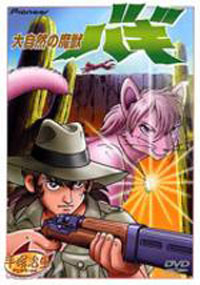 W
WBagi, the Monster of Mighty Nature is an anime movie that premiered on the Nippon Television network on August 19, 1984. It was written by Osamu Tezuka as a critique of the Japanese government's approval of recombinant DNA research that year.
 W
WBelladonna of Sadness is a 1973 Japanese animated art film produced by the animation studio Mushi Production and distributed by Nippon Herald Films. It follows the story of Jeanne, a peasant woman who turns to witchcraft after she is raped by the local nobility on the night of her wedding day. It is notable for its erotic, violent, and psychedelic imagery and considered a cult film.
 W
WBig X is a science fiction manga series and an anime series by Osamu Tezuka, based on actual experiments conducted by the Nazis to create secret weapons toward the end of World War II. The anime is considered lost, with only episodes 1, 11, and 40-59 known to survive.
 W
WBlack Jack is an episodic Japanese manga series written and illustrated by Osamu Tezuka in the 1970s, dealing with the medical adventures of the title character, doctor Black Jack.
 W
WBlue Blink is a fantasy adventure anime series created by Osamu Tezuka. The anime is based from classic film Konjok-gorbunok by Ivan Ivanov-Vano. The film in turn is based from Pyotr Pavlovich Yershov's The Little Humpbacked Horse.
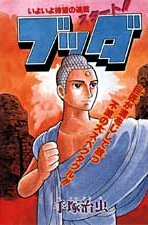 W
WBuddha is a manga drawn by Osamu Tezuka and is Tezuka's unique interpretation of the life of Gautama Buddha, the founder of Buddhism. The critically acclaimed series is often referred to as a visually explicit yet humorous and thought-provoking portrayal of the Buddha's life; the series itself has become a staple text in Buddhist temples for young adults and teens to learn about the Buddha's life. The series began in September 1972 and ended in December 1983, as one of Tezuka's last epic manga works.
 W
WCleopatra is a 1970 Japanese fantasy film directed by Osamu Tezuka and Eiichi Yamamoto. The film was a critical and commercial failure. A manga adaptation of the film, also from Tezuka and Hisashi Sakaguchi, was released later that same year in October exclusively in COM, and was reprinted in late 2018.
 W
WDon Dracula is a manga by Osamu Tezuka that began serialization in 1979. An anime television series aired from April 5 to April 26, 1982.
 W
WDororo is a 2019 anime television series produced by MAPPA and Tezuka Productions based on the manga of the same name by Osamu Tezuka, and is a re-adaptation of the previous 1969 series. The adaptation departs from the source material in several ways, but follows the basic premise of the manga: a young ronin, named Hyakkimaru, along with a young urchin, Dororo, must face multiple demons in Sengoku-era Japan who have stolen his various body parts in order to get them back.
 W
WGokū no Daibōken is a Japanese anime series that was directed by Gisaburō Sugii. Made by Mushi Productions, the anime's 39 episodes were broadcast on Fuji TV between January 7, 1967 and September 30, 1967. The anime is based on the 16th-century novel Journey to the West.
 W
WHidamari no Ki is a Japanese manga series written and illustrated by Osamu Tezuka about a friendship between a samurai and a doctor in the final days of the Tokugawa Shogunate. Hidamari no Ki received the Shogakukan Manga Award in 1984 for general manga.
 W
WJetter Mars is an anime series directed by Rintaro and written by Osamu Tezuka. Originally planned by Tezuka as a full-color remake of the original anime adaptation of his popular manga series Astro Boy, unfavorable circumstances during the pre-production phase of the project led him to abandon it temporarily and create Jetter Mars instead. Although it remains as one of Tezuka's lesser known works, it gained a large following and is fondly remembered.
 W
WJungle Emperor Leo, known in Japan as Jungle Emperor The Movie is a 1997 Japanese animated film focusing on the last half of Osamu Tezuka's manga, Jungle Taitei.
 W
WKimba the White Lion, known in Japan as Jungle Emperor , is a Japanese shōnen manga series written and illustrated by Osamu Tezuka which was serialized in the Manga Shōnen magazine from November 1950 to April 1954. An anime based on the manga was created by Mushi Production and was broadcast on Fuji Television from 1965 to 1967. It was the first color animated television series created in Japan. It began airing in North America from 1966. The later series was produced by Tezuka Productions.
 W
WLeo the Lion is a sequel to the Japanese anime television series Jungle Emperor, or Kimba the White Lion. Osamu Tezuka had always wanted his story of Kimba to follow Kimba's entire life, and the Jungle Emperor/Kimba series was such a hit in Japan that Tezuka produced a sequel, without his American partners, in 1966. An English dub of the series was first broadcast in the United States in 1984 on the CBN Cable Network.
 W
WLion Books is a 1950s Japanese manga series by Osamu Tezuka. It was published by Shueisha in the Omoshiro Book as a supplement. The same company published Lion Books II in Weekly Shōnen Jump in the 1970s, which would commonly be referred to as The New Lion Books. The series was partially adapted into an experimental anime series in the 1980s and 1990s.
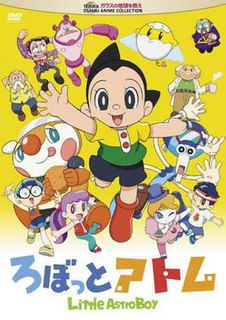 W
WLittle Astro Boy is an anime television spin-off series Astro Boy franchise created by Osamu Tezuka. Aimed at preschoolers, the series was produced by Tezuka Productions and Yomiuri TV Enterprises in partnership with Nigerian broadcaster Channels TV.
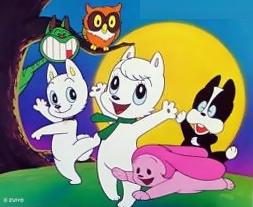 W
WLittle Wansa is a mascot for Sanwa Bank designed by Osamu Tezuka. It was later turned into a manga series by Tezuka and an anime series from 1973.
 W
WMarvelous Melmo is a magical girl manga and anime by Osamu Tezuka. This series centered on Melmo, a nine-year-old girl whose mother is killed in an auto accident and has to then take care of her two younger brothers. While in Heaven, the children's mother is given one wish. Her wish is that Melmo will be allowed to grow up more quickly than usual, since their lives as children will be difficult without their parents.
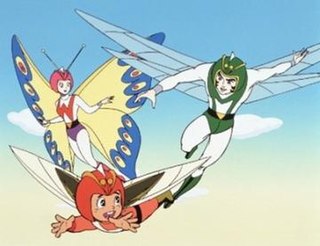 W
WMicrosuperman is a manga series written and illustrated by Osamu Tezuka, published in Akita Shoten's Weekly Shōnen Champion from March 1973 to September 1973. It was later adapted into an anime series by Toei.
 W
WMitsume ga Tōru is a Japanese manga series written and illustrated by Osamu Tezuka. It was originally serialized in Weekly Shōnen Magazine from 7 July 1974 through 19 March 1978 and was later published into thirteen tankōbon volumes by Kodansha.
 W
WThe New Adventures of Kimba The White Lion is an anime television series produced by Tezuka Productions that first ran from October 12, 1989, to October 11, 1990, on TV Tokyo. It is a remake of Osamu Tezuka's 1960s anime series Kimba the White Lion.
 W
WPhoenix is an unfinished manga series by Osamu Tezuka. Tezuka considered Phoenix his "life's work"; it consists of 12 books, each of which tells a separate, self-contained story and takes place in a different era. The plots go back and forth from the remote future to prehistoric times. The story was never completed, having been cut short by Tezuka's death in 1989. Several of the stories have been adapted into anime series and OVAs, and a live-action movie. As of 2007, the entire manga series is available in English-language translations.
 W
WPhoenix 2772 is a 1980 Japanese animated science fiction fantasy drama film directed by Taku Sugiyama and written by Osamu Tezuka and Sugiyama. The film is based on Tezuka's manga series Phoenix.
 W
WPrincess Knight, also known as Ribon no Kishi, is a Japanese manga series written and illustrated by Osamu Tezuka. This manga follows the adventures of Sapphire, a girl who was born accidentally with a blue heart of a boy and a pink heart of a girl. She pretends to be a male prince to prevent the evil Duke Duralumin from inheriting the throne of Silverland. The gender-bending main character was inspired by the all-female musical theater group Takarazuka Revue in which women performed both female and male roles.
 W
WA Thousand and One Nights is a 1969 adult Japanese anime feature film directed by Eiichi Yamamoto, conceived by Osamu Tezuka. The film is a first part of Mushi Production's Animerama, a series of films aimed at an adult audience.
 W
WTriton of the Sea is a 1969 Japanese manga series created by Osamu Tezuka for Kodansha. The manga was adapted by TV Asahi into a 27-episode anime television series from April 1 to September 30, 1972, directed by Yoshiyuki Tomino. Digital Manga successfully crowd-funded the U.S. release of the manga on Kickstarter in 2012.
 W
WUndersea Super Train: Marine Express is an anime television film created for the Nippon Television Network's annual 24-hour charity program, Ai wa Chikyū o Suku, which roughly translates to "Love Saves the Earth". The movie contained a veritable "Who's Who" of Tezuka's notable characters. Each one had an important role, and many of them had individual, intertwining stories which would overlap with the ones of others. To coincide with the central theme of the charity program, the movie emphasized on the dangers of environmental destruction, and that such disasters can be overcome by banding together.
 W
WUnico is a manga and anime character by Osamu Tezuka. Unico is a baby unicorn with white fur, a pink mane, and little cinnamon bun-shaped ears, who was born with the very special gift of making all living creatures lighthearted and happy.